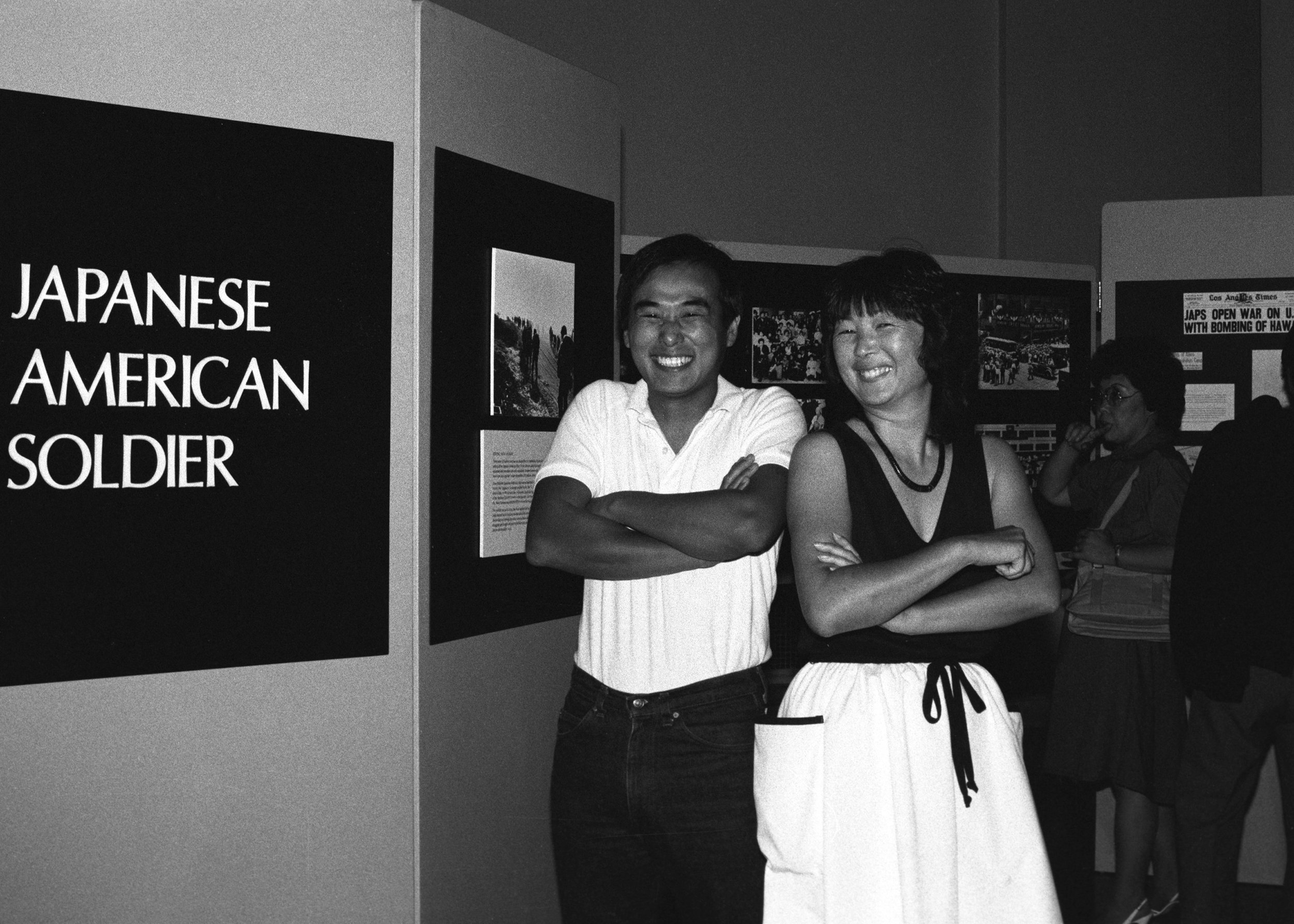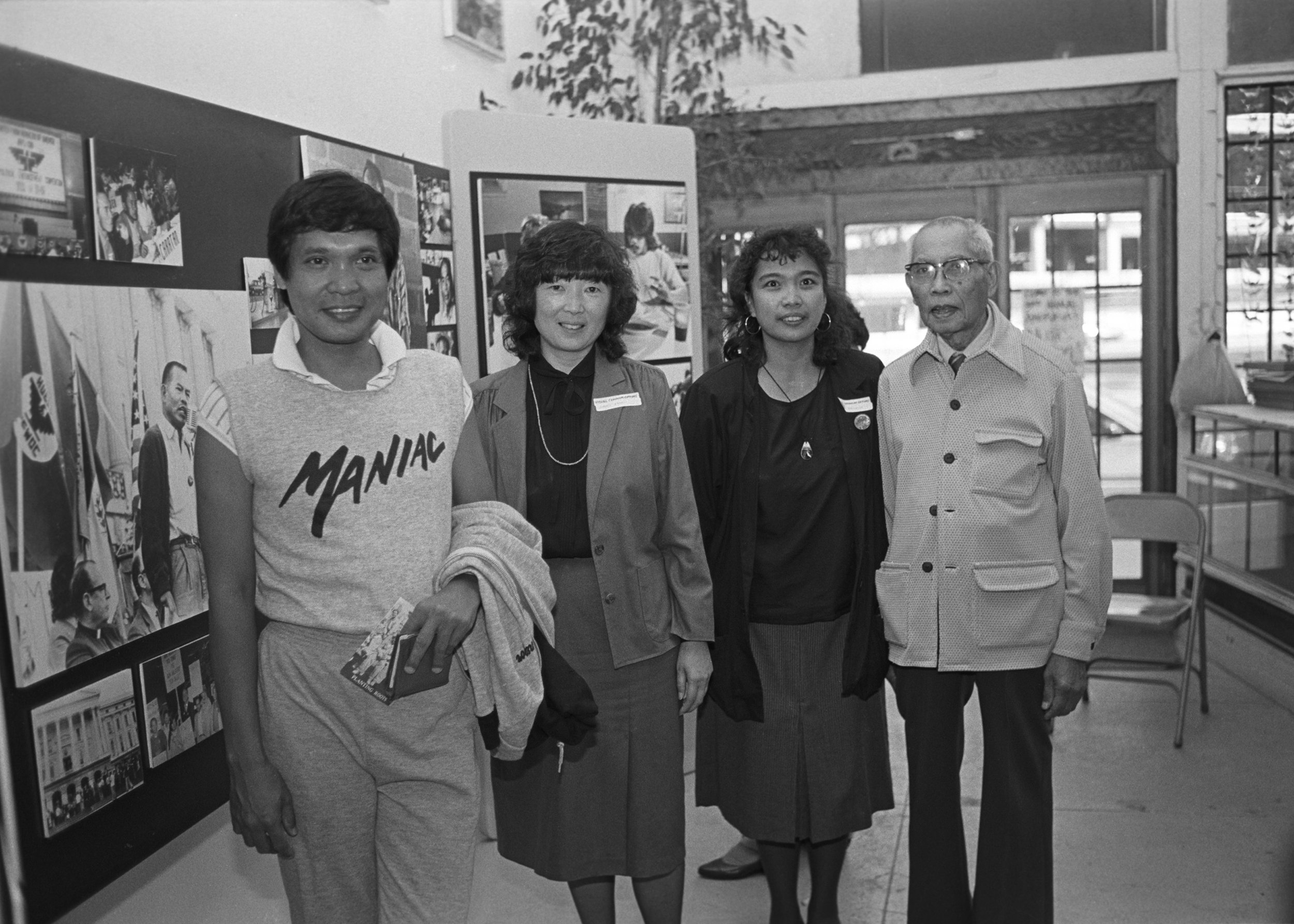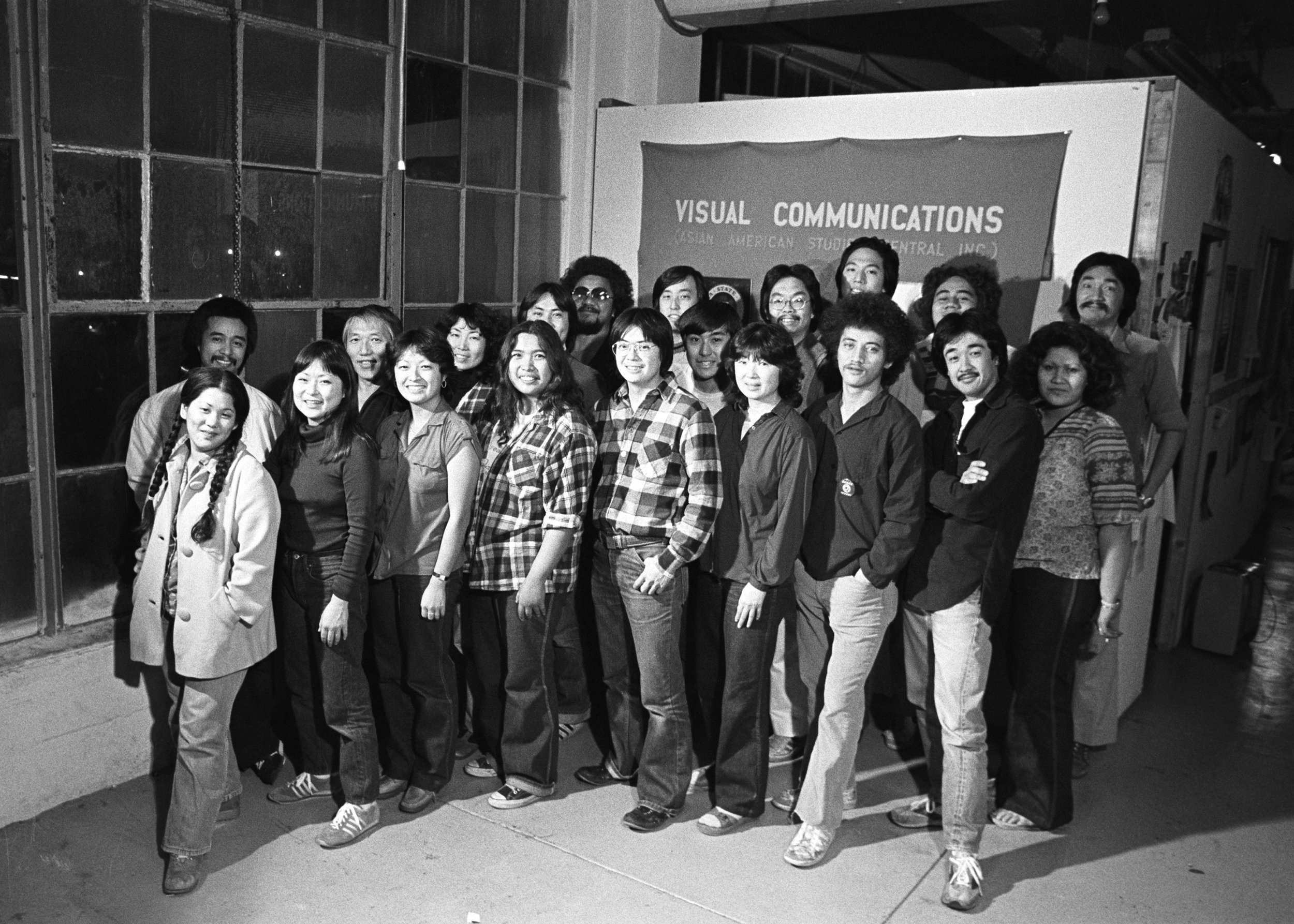The Womxn Who Saved VC
/Today we celebrate the life and long-lasting legacy of Linda Mabalot, who was the beloved Executive Director of Visual Communications from the mid-’80s until her passing in 2003. Please join us in honoring Linda by reading more below about how she guided Visual Communications out of its most challenging time and helped grow it into the community committed organization it is today.
The article below, “The Womxn Who Saved VC” was written by Abraham Ferrer for the online journal ET AL: NEW VOICES IN ARTS MANAGEMENT. The collection contains writing from nearly twenty arts administrators, arts activists, and cultural workers, was released through the Illinois Open Publishing Network (IOPN) under the stewardship of editors Amy Shimshon-Santo and Genevieve Kaplan. The journal also features the article “Using Our Superpowers: Dismantling Exclusion and Racism in Arts Management” from one of VC’s board members, Gerlie Collado.
Visual Communications staff members Linda D. Mabalot and Nancy K. Araki
Two young women smiling at the camera; behind them is a bookcase full of binders. Source: Visual Communications Photographic Archive
The Womxn Who Saved VC
by Abraham Ferrer
Heading into its second decade of service as the nation's premier Asian American media-making organization, Visual Communications (https://vcmedia.org/mission-history) (VC) found itself teetering on the brink of insolvency. An ambitious, feature-length film project documenting Los Angeles’ Japanese American community and its fight against community redevelopment went way over budget, resulting in a crushing $150,000 debt. The organization's main avenue of federal educational production funding was cut off as a result of the Reagan Administration’s new priorities, and staff members left in droves, reducing the working staff to a virtual skeleton crew of three people. Two remaining staffers—Nancy Araki, originally from the San Francisco Bay Area, and Linda Mabalot, a native of the Sacramento Delta farming town of Dixon—engineered a series of policy changes that eventually retired the debt and re-imagined the way in which the organization would move forward in fulfilling its reputation as the “media arm” of the Asian American Movement. In the process, Araki and Mabalot together altered the power dynamics of VC; they took it from a male- dominated organization, typical of many community-based organizations born during the transformative 1960s and 1970s, to an organization run and managed by women arts administrators, filmmakers, and advocates. This new organization had an unwritten rule that its affairs would be conducted with egalitarianism and a steadfast allegiance to the communities whose stories and perspectives it honored and created.
In 1981, at the invitation of then-core staff member Linda Mabalot, I first set foot in the Little Tokyo offices of Visual Communications. The space, a 4,000-plus square-foot loft that occupied the entire third floor of a four-story hat-making factory, was a beehive of activity. In one section, staffers were busy editing a video in one of the two post-production bays overlooking San Pedro Street, while in another corner, a gaggle of artists were gathered around a large light-table, laying out page comps for the latest issue of the Nikkei Sentinel, the official news magazine of the community advocacy group Little Tokyo Peoples’ Rights Organization (LTPRO). LTPRO freely used the VC offices to hold their regular meetings. The epicenter of the nation’s premier Asian American filmmakers’ collective definitely was a constant buzz of activity.
Visual Communications’ braintrust strategize a support plan for the organization’s current projects, June 1982
(from left): Nancy K. Araki, Board President Douglas Aihara, Linda D. Mabalot stand in front of a chalkboard full of notes. Source: Visual Communications Photographic Archive
Cut to one year later, 1982: the next time I visit VC is in a cramped 500 square-foot office space in the new Japanese American Cultural & Community Center (JACCC). The dramatic downsizing, due to drastic operational cutbacks, also came with a human cost. Virtually all staff members I met the previous year were gone, leaving a two-person staff to manage the entire operation. The president and ringleader of VC, the visionary and irrepressible Steven Tatsukawa, was now holding down a day job at KCET-TV, leaving the day-to-day business of running VC to two women who coordinated the activities of contract workers and part-time staff. Running VC in those challenging times were Nancy K. Araki and Linda D. Mabalot. They’d both arrived in LA around 1978 under different circumstances and became involved with VC just as the organization was launching into a particularly frenetic period of film and media production. Nancy stayed on through the end of summer 1985. Linda was appointed Executive Director in 1985, nearly a year after Tatsukawa’s untimely death in 1984, and led VC through a series of game-changing permutations until her passing at age 49 in 2003. Nancy and Linda, who served as friends and mentors during a particularly precarious period at VC, were unorthodox visionaries who brought a new and dynamic generation of audience and community to VC. At the same time, they upended, in their own ingratiating and homespun ways, the male-centric power dynamics of Asian American and Pacific Islander community groups of the day. To look back on Nancy and Linda’s impact on VC is to bear witness to a progressive movement in flux.
Visual Communications was in many ways a far different outfit at the cusp of the 1980s than it is today. And yet the troubling sociopolitical times in which the organization found itself forty years ago could not be more similar to America's current social and cultural quagmire.
Upon his election in 1980, then-President Ronald Reagan set about the dismantling of the Department of Education—formerly the Office of Education, and a key source of VC’s early production funding via the agency’s Emergency School Aid Act (ESAA)—in the belief that the federal government should yield administering affairs of education to state and local governments. Reagan never quite achieved his objectives: he fired his first Education Secretary, Terrel H. Bell, who changed his mind about carrying out the President’s directives. Bell’s replacement, William J. Bennet, was equally unsuccessful at eviscerating the Education Department and recasting it as a foundation. However, the Reagan Administration was successful in initiating cuts to the Department that hindered its ability to provide equitable educational opportunities for all Americans. Among others, those cuts spelled the end of the ESAA, in effect halting VC’s federal support to produce media materials for both local communities and schools (1).
Likewise, the Reagan Administration, initially under the guidance of Office of Management and Budget Director David Stockman, advocated for the elimination of both the National Endowment for the Arts and the National Endowment for the Humanities by branding both agencies as wasteful uses of taxpayer dollars (2). Instead, a special task force that included close Reagan allies, actor Charlton Heston and beverage magnate Adolph Coors, persuaded the President that both the Arts and Humanities endowments deserved continued federal support. That, however, did not prevent the Reagan Administration from attempting a planned 50% cutback of the NEA’s budget in 1981 (3).
Also in the early 1980s, US Immigration and Naturalization Service raids on communities of color to ferret out undocumented immigrants were rampant (4). These raids (some of which visited Little Tokyo in early 1982) were relatively genteel compared to the recently- concluded Trump Administration’s actions to vilify migrants as cancerous criminal elements that needed to be eliminated from American society—in spite of his seeming willingness to exploit undocumented labor (5).
Between 1980 and 1981, nearly all of VC’s core staff members exited the organization amid government funding cuts, the desire to seek other career opportunities in the entertainment field, and an outstanding $150,000-plus production debt incurred from the realization of a feature-length narrative film in 1980. Some of those exiting staff helped to shepherd VC during the height of the Asian American Movement in the 1970s, after their mass departure resulted in a near-shuttering of the organization. Without that valuable institutional and professional knowledge to steer VC through rough waters, dissolution seemed imminent.
Into this gathering storm of cutbacks and conservative headwinds came a new generation of VCers. Early on, staff members worked to develop and define a larger community-based movement and a “serve the people” ethos through their involvement with VC and other arts and social service initiatives. These included the Asian American Drug Abuse Program (https://aadapinc.org/), Asian American Volunteer Action Committee, Chinatown Teenpost, the Pacific Pioneer Project, Search to Involve Pilipino Americans, Inc. (https://sipacares.org/about/), the T.H.E. Clinic for Women, as well as a network of communal living spaces tied to the social and political interests of the residents of these “themed” dwellings. Beginning in the late 1970s, a new generation of VC staff members started arriving on the scene, ones with different sociocultural backgrounds, educations, and motivations for becoming involved. Some of them came from local film school programs that stressed the possibilities of careers in the mainstream entertainment arena. Others were products of such white imperialist institutions as college inter-fraternal and panhellenic societies. One was a high-school dropout who found his place at VC initially as a camera assistant, while a couple of others were strongly affiliated with koto (Japanese plucked half-tube zither instrument) schools and taiko (Japanese drum) companies associated with local Buddhist churches.
Linda D. Mabalot posing with a family photo
Woman posing in front of large-scale mobile photo exhibit PLANTING ROOTS: FILIPINOS IN CALIFORNIA, May 4, 1988 Source: Visual Communications Photographic Archive
While not native Angelenos, Nancy Araki and Linda Mabalot each brought a distinct Northern Cal flair to VC, even as the political and social power-base of the Asian American media movement shifted from Los Angeles and New York City to the San Francisco Bay Area, starting with the 1980 establishment of the National Asian American Telecommunications Association (re-christened in 2004 as the Center for Asian American Media (https://caamedia.org/)). Nancy, whose family was incarcerated at the Amache, CO, and later the Topaz, UT, concentration camps for Japanese Americans during World War II, was the author of cultural books including MATSURI: FESTIVAL, a 1978 activities book written and illustrated by Nancy and Jane Horii. After relocating to Los Angeles in early 1979, Nancy served as the casting director and crew member for VC’s debut feature-length project Hito Hata: Raise the Banner (https://www.imdb.com/title/tt1479681/). Linda, an alumna of UC Davis, executed a career pivot from medical school to community activism; this was a direct result of the affirmative action struggles surrounding the US Supreme Court’s 1978 Bakke Decision ruling (https://supreme.justia.com/cases/federal/us/438/265/) (6). Linda and other Asian American and Pacific Islander student activists of her generation became involved with the statewide Asian Pacific Student Union (APSU), which formed in 1978 in response to the Supreme Court ruling. After relocating to Los Angeles to refocus her career aspirations on media activism, Linda found time to work on several VC productions outside of the massive Hito Hata film project, and actively sought to recruit a new generation of budding media activists into the VC fold in response to the 1981 exodus of staff. Linda often recruited Asian American college undergraduates from the “house-party” circuit who, like herself during her college years, were just beginning to explore their social and political activism.
With the Reagan Administration’s debilitating cuts to arts, culture, and education funding, and without forthcoming funding streams for productions, many VC staff members left to find work to support their professions and families or completely abandoned arts and media production altogether. By the beginning of 1982, VC had become a virtual ghost town in its new location at JACCC. The VC of my early memories involved Nancy and Linda co-running the office while Steve functioned as a sort of invisible Executive Director. UCLA Film School student John Esaki, a part- time grant writer, and Amy Kato, a USC graduate who worked part-time as Office Manager, were the main holdovers from the Hito Hata production. Like many remaining staffers at that time, VCers were paid through a special on-the-job training program that Nancy and Linda leveraged with some “creative” job hiring strategies. Along with Kaz Takeuchi, a drop-in volunteer who ran VC’s black-and-white photographic darkroom when he wasn’t working days as a union set-builder at 20th Century Fox Studios, this skeleton team of part-timers held VC together during what should have been some dark times.
Stephen Gong, Linda D. Malbot, and Nancy Araki
As Visual Communications Boardmember Stephen Gong listens, Linda and Nancy lay out an ambitious visioning plan at a staff and board retreat. January 1986. Source: Visual Communications Photographic Archive
And yet, Nancy and Linda saw VC’s predicament during the early ‘80s not as a fatal reckoning of its very being, but as a prime opportunity to remake the organization and to adapt it to the changing cultural, social, and political landscape facing the Asian American community. VC, which had largely been a male-centric filmmakers cooperative during its first decade of existence, could re-imagine its identity and broaden its capabilities without compromising its allegiances to the communities and movement that it served. With Nancy and Linda running things, VC would be guided with a whole different mindset, from a distinctly “wimmynistic” perspective (7).
To renew VC, a series of radical shifts had to be made in both identity and how business would be conducted with the community. Right away, Nancy and Linda set about repositioning the mission and purpose of the organization. In a now-famous manifesto presented to the Board of Directors in 1982, Linda directly challenged VC’s board to take responsibility for steering it out of a yawning fiscal chasm and to reaffirm the organization’s values and its commitment to community-based, grassroots media production. Even more significantly, this “Fold or Fight!!!!” declaration called for a structural overhaul of Visual Communications, taking it from a filmmakers’ cooperative to a media arts center. Nancy and Linda envisioned harnessing VC’s vast media resources, amassed over the course of its first twelve years, to better serve the communities whose stories and experiences inspired its creative output, and to pull back on the Hollywood-style aspirations that put VC in a financial hole in the first place. Nancy and Linda knew that failure to adapt was a roadmap to financial ruin, liquidation, and the loss of a key community resource where none had previously existed. Failure to adapt was not an option.
Fold or Fight!!!!
Page one of VC's 1982 typed manifesto; includes Section 1: To Fold and Section II: To Fight. Source: Visual Communications Photographic Archive
Another way in which Nancy and Linda asserted the “new VC” approach was to monetize its resources as a means of paying down its sizable production debt. This involved announcing that VC’s assets could no longer be available for free, or at a deep discount, to fellow community members and activists. Shifting to charging sales or rental fees to those who were similarly strapped for cash was seen as un-neighborly, and brought charges of elitism and capitalism to VC’s doorstep from some community members. Nancy and Linda stuck to their guns and refused to give in to friends and colleagues seeking steep discounts for VC’s shareable assets of photos, films and videos, and photo exhibitions. They knew that goodwill, no matter how altruistic, would do nothing to pay the rent . . . or to make the massive production debt disappear.
the Media Center Concept
Page two of VC's 1982 typed manfesto; includes the sections "The Media Center Concept" and "The Bottom Line." Source: Visual Communications Photographic Archive
As a prime example of this new mode of monetizing VC’s production resources, Nancy and Linda teamed with Amy Kato to establish pricing guidelines for VC’s assets, like use of the photographic darkroom, as well as to promote its award-winning films and video programs for the educational market and for community-based grassroots organizations. Borrowing a page from Betty Chen, a first-generation VCer who recognized early on the importance of engaging audiences and prospective users for its products (her mantra: “We must not ‘distribute’ . . . we must ‘market’”), staffers piggy-backed on Distribution Manager John Rier’s aggressive salesmanship of VC products during the organization’s “Fold or Fight!!!!” period, which resulted in a series of lucrative licensing agreements for Hito Hata which significantly reduced the organization’s debt. Slowly but surely, once VC clearly assessed its resources for both non-profit and commercial uses, a small and steady revenue stream developed that allowed VC to support its then-modest ambitions, and raised awareness for its photographic archive and filmography.
Nancy and Linda also tag-teamed frequently with John Esaki, a gifted and imaginative writer and filmmaker, to take up the slack when many of VC’s grant-writing staff exited the organization. Over time, the three of them worked out an assembly-line approach to writing grants. John almost always took care of writing the proposal narrative, while Linda, using a unique “seat of the pants” approach to fleshing out budgets with Nancy, would take care of the numbers and somehow make them jibe with John’s narratives. The many grants received during this period— from the City of Los Angeles’ Cultural Affairs Department to major awards from the John D. and Catherine T. MacArthur Foundation, and from commercial companies that sought VC’s expertise in promoting a wide variety of consumer items to the Asian American market—served as a crucial bridge to a wider audience.
Visual Communications’ Nancy K. Araki, shown attending the unveiling of the VC and 110th/442nd/MIS Museum Foundation photo exhibit JAPANESE AMERICAN VETS, circa February 1984
Woman smiling at the camera, giving thumbs up at a painting behind her. Source: Visual Communications Photographic Archive
For instance, Nancy’s most lasting legacy while at VC was to enjoin the support of Japanese American World War II veterans as key supporters and donors. As the exploits of the Nikkei 8 veterans of the 442nd Regimental Combat Team and 100th Battalion (and, not much later, those of the Military Intelligence Service) became intertwined with the burgeoning movement for monetary redress for incarcerated Japanese Americans, Nancy saw the importance in VC embracing the veterans whose stories formed the basis for many of its past productions. Nancy’s own story as a former incarceree, a distinction unique among youngish staff, strengthened the linkage between VC and Nikkei vets. This resulted in a long-time relationship that ranged from Nikkei vets’ perennial appearances at many of VC’s annual fundraisers to their regular support for VC’s most far-reaching program initiatives, including the Filmmakers Development Program, a series of community video workshops, the then-nascent annual Los Angeles Asian Pacific Film Festival, and so much more.
As for Linda, most of the staffers at that time seemed bemused by her reluctance to accept sponsorship monies from companies that exercised questionable business policies towards minorities and chronically underserved communities. For instance, her steadfast refusal, on political principle, to so much as sniff at money and product thrown at her feet by representatives of the Adolph Coors Brewing Company became a major sticking point with Asian American Coors marketing personnel. Throughout the 1980s, Coors spent much time, money, and energy throughout communities of color to rehabilitate its image, which had been marred by discriminatory hiring and workplace practices against members of the Mexican American and LGBTQ communities (9). While some groups, most notably the then-Los Angeles Lesbian and Gay Media Coalition, made themselves conspicuous in their acceptance of Coors sponsorship and advertising monies, Linda held her ground and only began to accept Coors monies and product after it was learned that the Coors family reversed its discriminatory policies in the mid-1990s. Though she was a two-pack-a-day smoker until her last days, Linda likewise refused to accept sponsorship money or products from tobacco companies. Given that many of VC’s community fundraising events reflected a growing cross-generational patronage of VC and its mission, Linda and others rightly determined that promoting risky health behavior for the upcoming generation, whom she dubbed the “youngbloods,” was a bad example to endorse.
All these changes in work habits and organizational culture culminated in VC’s 15th anniversary gala at the then-Japan America Theatre in August 1985. Though Steve Tatsukawa’s passing the previous winter weighed heavily on the hearts of many in the audience that night, the nearly four years of hard work overseen by Nancy and Linda resulted in dividends that no one could foresee in 1981:
The complete retirement of the $150,000 production debt.
The completion of yet another major Visual Communications film production, John Esaki’s Yuki Shimoda: Asian American Actor, which world-premiered at the 15th Anniversary Gala.
The completion of not one, but two major mobile photographic exhibits: a Japanese American History exhibit produced as a collaboration between Visual Communications and the Japanese American National Museum; and PLANTING ROOTS, created with California Arts Council funds and spearheaded by Linda.
The creation of the print publication Little Tokyo: One Hundred Years in Pictures on the occasion of Little Tokyo’s centennial.
The 1983 launch of the Los Angeles Asian Pacific Film Festival.
The 1984 launch of the Filmmakers Development Program and VC’s decade-long foray into Super 8mm filmmaking.
The participation and backing of a new generation of VC supporters, exemplified by the creation of The Friends of Visual Communications, the organization’s first-ever paid membership vehicle, transitioned from the ad hoc national committee that oversaw the Hito Hata national community premiere roll-out.
As with just about all things Visual Communications, more changes were afoot during the wild and uncertain 1980s. Nancy left VC in September 1985 to become the Project Manager at the Japanese American National Museum; she would retire as its Director of Community Affairs in 2013. Linda carried on as VC’s Executive Director and brought fresh faces to the Board of Directors. In a nod to VC’s ongoing legacy, she installed co-founder Robert A. Nakamura as a board member and unofficial mentor to the staff. During her nineteen-year tenure, Linda brought VC into the digital age, presided over two major office moves before setting down permanent roots at its present location in the former Union Church of Los Angeles, and continued to inspire and mentor those “youngbloods” who comprise today’s Asian Pacific American media arts establishment. All the while, she befuddled colleagues and dismayed board members and staff with her leadership quirks. For example, she used a unique color-coding system to construct and maintain budget spreadsheets, received VIP guests and attended high-profile community gatherings in her uniform de guerre (a brown print muumuu and the ubiquitous open-toed “picky shoes”), and insisted on hiring staff based on some strange kind of intuition, of which I myself was a beneficiary, and which to this day I cannot quite understand. In fact, Nancy and Linda’s lack of anything remotely resembling a formal hiring practice may have been anathema to most “professional” non-profit organizations, but it was totally in character with how the two ran VC. To them, it wasn’t a grand scheme to show anyone what wimmyn could do in a male-dominant arena. Instead, it was a reflection of how the two recognized and nurtured up-and-coming talent that would impact the entire media arts arena, long after they each called it a day and departed VC.
Visual Communications is still around, forty years after Nancy Araki and Linda Mabalot took over for a legion of departing filmmakers. They fought with smiles on their faces and good cheer for VC's ideals and purpose. Their approach to recognizing and nurturing up-and-coming talent would impact the entire media arts arena for years to come.
1. Dan Bauman and Brock Read, “A Brief History of GOP Attempts to Kill the Education Dept.,” The Chronicle of Higher Education, June 21, 2018, https://www.chronicle.com/article/a-brief- history-of-gop-attempts-to-kill-the-education-dept/ (https://www.chronicle.com/article/a- brief-history-of-gop-attempts-to-kill-the-education-dept/).↵ (https://iopn.library.illinois.edu/scalar/etal/the-wimmyn-who-saved-vc#F01-ref)
“National Endowment for the Arts: 1981 Attempts to Abolish,” Wikipedia, April 23, 2021, https://en.wikipedia.org/wiki/National_Endowment_for_the_Arts (https://en.wikipedia.org/wiki/National_Endowment_for_the_Arts).↵ (https://iopn.library.illinois.edu/scalar/etal/the-wimmyn-who-saved-vc#F02-ref)
William H. Honan, “Book Discloses That Reagan Planned to Kill National Endowment for Arts,” New York Times, May 15, 1988, https://www.nytimes.com/1988/05/15/arts/book- discloses-that-reagan-planned-to-kill-national-endowment-for-arts.html (https://www.nytimes.com/1988/05/15/arts/book-discloses-that-reagan-planned-to-kill- national-endowment-for-arts.html ).↵ (https://iopn.library.illinois.edu/scalar/etal/the- wimmyn-who-saved-vc#F03-ref)
Peter Imamura, “Immigration raids alarm Little Tokyo,” Pacific Citizen, February 12, 1982, https://pacificcitizen.org/wp-content/uploads/archives- menu/Vol.094_%2306_Feb_12_1982.pdf (https://pacificcitizen.org/wp- content/uploads/archives-menu/Vol.094_%2306_Feb_12_1982.pdf).↵ (https://iopn.library.illinois.edu/scalar/etal/the-wimmyn-who-saved-vc#F04-ref)
Massimo Calabresi, “What Donald Trump Knew About Undocumented Workers at His Signature Tower,” TIME Magazine, August 25, 2016, https://time.com/4465744/donald- trump-undocumented-workers/ (https://time.com/4465744/donald-trump-undocumented- workers/). Kevin Liptak, Maegan Vazquez, Ariane de Vogue, and Catherine E. Shoichet, “Trump signs order targeting undocumented immigrants in the US census,” CNN: Politics, last updated July 21, 2020, https://www.cnn.com/2020/07/21/politics/white-house-census- undocumented-immigrants/index.html (https://www.cnn.com/2020/07/21/politics/white-house-census-undocumented-immigrants/index.html).↵
(https://iopn.library.illinois.edu/scalar/etal/the-wimmyn-who-saved-vc#F05-ref)
Regents of Univ. of California v. Bakke, 438 U.S. 265, (1978),
https://supreme.justia.com/cases/federal/us/438/265/ (https://supreme.justia.com/cases/federal/us/438/265/).↵ (https://iopn.library.illinois.edu/scalar/etal/the-wimmyn-who-saved-vc#F07-ref)
In 1981, as the editor of an Asian Pacific newsmagazine at UCLA, I ran across the flyer of an upcoming program on African American women writers entitled, “The Subject Waz Wimmin.” I was taken by the notion that the event organizers framed themselves and their event in resolutely anti-colonialist language—even going so far as to invent a new vocabulary and a clever, cheeky way of writing out how they would choose to identify themselves. While I continue to endorse the identifiers “wimmin” and “wimmyn” (plural) to signal a claim of anti- colonialist, anti-sexist, and thoroughly self-determined nomenclature, I recognize that in 2021, the term may be out of vogue to a generation infatuated with current identifiers such as “gender nonconforming.”↵ (https://iopn.library.illinois.edu/scalar/etal/the-wimmyn-who- saved-vc#F08-ref)
Japanese American is, generally, a term used to define native-born Americans of Japanese descent who, with few exceptions, have grown up from birth never setting foot on Japanese soil. ↵ (https://iopn.library.illinois.edu/scalar/etal/the-wimmyn-who-saved-vc#F09-ref)
“Adolph Coors Company (A),” Business Case, Tuck School of Business, Dartmouth College, Archived from the original PDF on May 27, 2006, https://studylib.net/doc/8074032/adolph- coors-company---tuck (https://studylib.net/doc/8074032/adolph-coors-company---tuck).↵ (https://iopn.library.illinois.edu/scalar/etal/the-wimmyn-who-saved-vc#F10-ref)
Continue to “Reimagining African American History Through Prosthetic Memory and Family Archives” (https://iopn.library.illinois.edu/scalar/etal/reimagining-african-american-history-- through-prosthetic-memory-and-family-artifacts?path=stream---rooted-in-histories)
VCers Weigh in on Impact Of Arts Placemaking in New Issue of ET. AL. Journal
LOS ANGELES, CA – May 19, 2022 – Stories of arts placemaking in times of economic and political discord highlight a pair of articles from key members of Visual Communications, the nation’s premier Asian Pacific American media arts organization in the recently-release journal ET AL: NEW VOICES IN ARTS MANAGEMENT. The online journal, containing writing from nearly twenty arts administrators, arts activists, and cultural workers, was released through the Illinois Open Publishing Network (IOPN) under the stewardship of editors Amy Shimshon-Santo and Genevieve Kaplan.
Compiled and edited in the midst of a “perfect storm” of a global pandemic, a racial reckoning involving multiple communities of color, and a divisive U.S. Presidential campaign, ET AL, as described by the editors in the publication synopsis, “contributes to the conversation about arts and cultural management by providing rare, behind-the-scenes insights on justice-centered arts management praxis — ideas tied to action.
“[ET AL] makes space for people to publicly reflect, write, and share insights about their own ideas and ways of working. As a digital publication, the platform lends itself to multi-media knowledge objects; the experiences documented within it include ethnographies, qualitative social research, personal and communal manifestos, dialogues between peers, visual essays, videos, and audio tracks.”
Among the many insightful contributions are key offerings by two of Visual Communications’ veteran arts administrators whose ongoing work has encompassed both grassroots and institutional spaces.
In Gerlie Collado’s searing preface “Using Our Superpowers: Dismantling Exclusion and Racism in Arts Management,” the current grants and administrative lead of The Panta Rhea Foundation ruminates on her journey from a high school youth who recognized early on the ‘cultural imperialism” at work at the local museum in her San Joaquin Valley neighborhood; to her long-time advocacy on behalf of Pilipino American cultural and contemporary artists as a board member of FilAm ARTS, Inc. Along the way, Collado calls out the damaging effects of exclusion and erasure of peoples of color from the curation, organizing, and management of artistic and cultural gathering spaces. Collado, currently serving a term as a board member of Visual Communications, advocates for Asian American and Pacific Islander cultural place makers to call for an end to invisibility in mainstream arts organizations, and to take ownership of how the artistic perspectives of communities of color are positioned to the broader society.
In Visual Communications staff member Abraham Ferrer’s nostalgia-tinged “The WimmXm Who Saved VC,” the turbulent 1980s — a period buffeted by both the conservative Reagan Years and persistent threats to culture and the arts — is seen through the eyes of Northern California transplants Nancy K. Araki and Linda D. Mabalot, who oversaw the organization in the wake of massive funding deficits and a staff exodus that threatened to dissolve the pioneering filmmakers’ cooperative in 1982. Re-engineering the organization into a full-service “media arts center,” both Araki and Mabalot effected a series of drastic changes that were seen as anathema to the way that grassroots community arts organizations operated in those times, but which turned out to introduce much-needed and forward-thinking sustainability practices to VC, and positioned it to better serve Greater Los Angeles’ Asian American and Pacific Islander communities.
“For today’s generation of cultural workers and arts place-makers, it’s too easy to overlook the considerable ‘institution-building’ that undergirds the important work we all do in order to be ‘seen’ in American society,” says current Visual Communications Executive Director Francis Cullado. “Collectively, the insightful writings contained within the pages of ET AL provide a much-welcome blueprint for how we as cultural workers of color drive our efforts at creating and sustaining multiple spaces where our artistic perspectives are a vital part of the larger fabric of the American Experiment.”
Cullado added, “The inclusion of the valuable contributions by VCers Gerlie Collado and Abraham Ferrer brings to light largely unknown chapters of VC’s long history, and serves as a ‘wake-up call’ to our communities. We’re privileged to have been included in the pages of ET AL, and encourage one and all to engage with this important new publication.”
ET AL: NEW VOICES IN ARTS MANAGEMENT is an open source publication published by Publishing Without Walls (PWW) of Urbana, IL, part of the Illinois Open Publishing Network. Contributors include: Amy Shimshon-Santo, Genevieve Kaplan, Gerlie Collado, Abraham Ferrer, Julie House, Britt Campbell, Delia Xóchitl Chávez, Sean Cheng, Yvonne Farrow, Allen Kwabena Frimpong, Kayla Jackson, Erika Karina Jiménez Flores, Cobi Krieger, Loreto Lopez, Cynthia Martínez Benavides, Christy McCarthy, Janice Ngan, Cailin Nolte, Michaela Paulette Shirley, Robin Sukhadia, Katrina Sullivan, and Tatiana Vahan. The publication can be accessed at: https://doi.org/10.21900/pww.15
VC Connect: Remembering Linda Mabalot
MANONG (1978) by Linda Mabalot
The manong were the first wave of Filipinos who came to the United States to find work. MANONG dramatically portrays their lives as captured in the writings of Carlos Bulosan, unveiling the manongs‘ contribution to America’s agricultural and service industries and the struggle to build a Filipino community. MANONG tells the stories of their decades in the farmland and canneries on the West Coast and the effects of the bachelor society that lingers today.
YOU STILL CAN HEAR ME SINGING (1978) by Antonio De Castro and Linda Mabalot
Produced as a companion piece to the Philippine Hunger Project, this film examines the devastating effects of the root causes of hunger in Negros Occidental, Philippines caused by the monopolization of the island’s sole source of economic support — its sugar industry. Interviews with local politicians and academics are contrasted with images of the decimation of local staple industries that provide a crucial and, in many cases, sole source of income for families living at or near the poverty line.
APSU: EDUCATION AS A RIGHT (1988) by Linda Mabalot and Stann Nakazono
Produced to celebrate the ten-year anniversary of the statewide Asian Pacific Student Union (APSU), this film observes the rise of a new generation of Asian Pacific American student activists in the wake of the U.S. Supreme Court’s landmark 1978 Bakke Decision. Interviews with founders and activists involved with APSU members, former student activists, educators, and local and national politicians paint the portrait of the next generation of Asian Pacific American activists and how grassroots activists began the long process towards empowerment and full participation in America’s social, cultural, and political processes.













